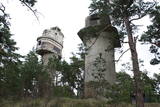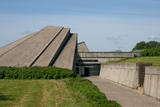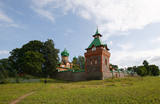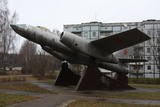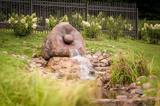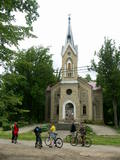| Nr | Name | Beschreibung |
|---|---|---|
|
Baltijas mērogā unikāls dabas un cilvēkizmantots apvidus, kas veidojies kādreiz - padomju, mūsdienās - Latvijas Nacionālo bruņoto spēku pārvaldītā armijas poligona teritorijā. Poligona lielāko daļu aizņem smilšains vai ar zemiem lakstaugiem un krūmāju apaudzis kāpu masīvs ar atsevišķiem lielākiem kāpu vaļņiem. Rudens laikā šeit lielās platībās zied virši. Unikālā virsāju un aprimušo kāpu ainava un daudzu sugu dzīves vieta bija daži no iemesliem, kādēļ šai militārai teritorijai ir piešķirts arī aizsargājamas dabas teritorijas statuss. Jāatgādina, ka poligona apmeklējumi privātpersonām bez iepriekšēja saskaņojuma ir aizliegti!
|
||
|
Eine der größten befestigten Siedlungen im Bezirk Harju, befindert sich auf einer Erhebung des natürlichen Kliffs Nordestlands. |
||
|
No ūdens tūrisma attīstības centra „Bāka” skatu laukuma, kas atrodas Lubāna ezera ziemeļdaļā pie V 560 autoceļa, paveras viens no labākajiem Lubānas ezera skatiem. Redzams milzīgais Latvijas lielākā ezera klajs un Kvāpānu – Īdeņas zivju dīķu ar dambjiem ainava. |
||
|
Am leichtesten kann man diese Batterie finden, wenn man entlang der Meeresküste geht, weil eine von den vier Positionen der Batterie am Strand liegt (abgespült von Meereswellen). Die übrige Positionen, Entfernungsmesser, als auch andere Elementen sind in der Nähe von der Meeresküste – im Kieferwald gelegen. Die Batterie wurde in den vierziger Jahren des vorigen Jahrhunderts aufgestellt. Von diesem Ort kann man die nördischen Befestigungswerke sehen.
|
||
|
After a big storm in 2005, the nature trail of the Randu meadows was restored. It is about 4 km long, and there is a bird-watching tower which offers a fine view of unique shoreline meadows with small lagoons and areas of reeds. It is a fine place to watch migrating birds. This is part of the Northern Vidzeme Biosphere Reserve (ZBR).
|
||
|
Ein am Ende des 19. Jh. gebautes Teil der Festung. Ein Museum, das Verbrechen totalitäre Regimes gegen Menschlichkeit wiederspiegelt. |
||
|
Das Museum wurde 2007 eröffnet. In der Exposition sind ein 180 mm Kanonenrohr, Rekonstruktion der Staatsgrenze, Zivilschutzräume, Panzerwagen, Grenzüberwachungsboot, Meeresminen. Im Hauptgebäude wird Beobachtungsradar, Waffenabstellraum, Kasernenmilieu und andere thematische Gegenstände präsentiert. |
||
|
Gauja ir Latvijas populārākā ūdenstūristu upe. Laivotājus šeit vilina skaistie smilšakmens atsegumi, upes mierīgais tecējums, dabas un lielā kultūras pieminekļu daudzveidība. Minētajā posmā upe plūst cauri Gaujas senlejai, kas ir viena no iespaidīgākajām Baltijas reljefa formām. Maršruta tehniski sarežģītākā vieta ir Ķūķu krāces, kur nereti gadās pa kādai apgāztai laivai. Lielākais upes kritums ir posmā no Amatas ietekas līdz Līgatnei, tādēļ daudzi braucēji izvēlas Cēsu – Līgatnes posmu. |
||
|
Im Hof werden verschiedene ländliche Leckereien zubereitet – Käse, Käsestangen u.a. Biologischer Landwirtschaftsbetrieb, in dem man selbst angebaute Podukte verwendet. Verkostungen und Erwerb von Podukten, Exkursionen für die Gruppen ab 10 Personen. |
||
|
Kloster von Kuremäe wurde im Jahr 1891 errichtet und es ist das einzige tätige russisch-orthodoxe Nonnenkloster in Estland. In den vergangenen Tagen befand sich hier der Hainort der altertümlichen Esten. Am Berg ist eine Opferquelle, die heute wegen seines heilenden Wassers als heilige Quelle genannt wird. Kloster ist für die Touristen geöffnet und alltägliches Leben der Klosterbewohner kann man besichtigen. Wer den ganzen Klosterkomplex besichtigen möchte, kann von Nonnen eine Führung bestellen. |
||
|
The large farm is to the South of the centre of Lone, producing apples, pears, plums, cherries, strawberries and black currants. It stores apples during the whole winter. You can help to pick the fruit and berries and purchase them for yourself. |
||
|
Im Dorf von Skulte ist ein seltenes Denkmal erhalten geblieben – Düsenflugzeug (Bombenflugzeug) aus der Zeit der Sowjetunion IL-28), das möglicherweise auch die geflügelten Raketen tragen könnte. Das Flugzeug ist auf drei betonierten Postamenten aufgestellt.
|
||
|
The restaurant-cafe Moka is situated in Estonia, in the city of Tartu, not far from Tartu university and offers a wide variety of foods. |
||
|
Die Brigade der Zenitraketen und der Stab der Meldegänger wurde für die Gewährleistung, Planung und Koordination der militären Funkverbindung genutzt. Zur Zeit wird das Objekt nicht genutzt und es wurde zu dem Zentrum der Repatriierung Lettlands und der Kristlichen Mission übergeben.
|
||
|
Во время путешествия Вы осмотрите знаменитую Гору Крестов, Старый Каунас. Со смотровых площадок или во время прогулки на кораблике Вы увидите живописные излучины реки Неман. В курортном городе Друскининкай Вы посетите Парк Грутас со скульптурами и памятниками советского периода, переживете ушедшие „советские времена”. Сможете на велосипеде прокатиться по Национальному парку Джукия – одной из нетронутой природной территории Балтии. Вечером можете насладиться SPA процедурами по Вашему желанию и отдохнуть в Друскининкайском аквапарке. |
||
|
Lielbātas dabīgais dzidravots ir lielākais Latvijā un viens no retajiem Ziemeļeiropā, kas zemes virspusē no dzīlēm iznes bioloģiski aktīvu un pareizi strukturētu ūdeni. Lielbātas dzidravots tek no rietumiem uz austrumiem pretī saulei, tāpēc jau izsenis tiek uzskatīts par maģisku, pat svētu, kam piemīt dziednieciskas spējas. Vēstures materiālos Lielbātas avots pirmo reizi pieminēts 1253. gadā un līdz šim brīdim turpina savu plūdumu. Lielbātas avots atrodas sakoptā un ekoloģiski tīrā vidē. Laikam ritot, avota ūdens plūsma nav mazinājusies, bet tieši pretēji, tā ir pieņēmusies spēkā un ar apbrīnojamu jaudu avots turpina dot unikālu dabas velti – tīru, bioloģiski aktīvu, pareizi strukturētu ūdeni, neapstājoties ne dienu, ne nakti, ne ziemu, ne vasaru. Netālu no avota atrodas vēsturiskā Vaiņodes jeb Lielbātas pils, kuru 19. gs. vidū būvēja barons Osten Sakens. Vēstures liecības liecina, ka šī vieta pils būvniecībai nav izvēlēta nejauši. 1923. gadā pilī tika izveidota sanatorija, kas ne tikai bija priekšzīmīgākā Latvijā, bet varēja cienīgi līdzināties ārzemju sanatorijām. Tam par iemeslu bija dabiski tīrā un dziednieciskā vide, kas saglabājusies līdz pat mūsdienām. Lielbātas pils ir privātīpašums un apmeklētājiem nav pieejama, taču Lielbātas avots ir brīvi pieejams, un katram ir iespējams nogaršot avota ūdeni. Adrese: Vaiņodes pils, Vaiņodes pagasts, Dienvidkurzemes novads LV-3535 |
||
|
Noch vor 20 – 30 Jahren wohnten in Roja Ilga Veidemane und LaimonisVeidemanis, die gehörlose Leute waren und schafften mit großer Liebe Segelschiffmodelle verschiedener Größe. Ein unrealisierter Traum über alte größe Schiffe und das weite Meer lag zu Grunde des Schaffens der Segelschiffmodelle. Diesen Leuten war leider nicht vergönnt, das weite Meer zu befahren. Die Segelschiffmodelle wurden mit hoher Präzision, Sorgfalt und großer Liebe gemacht, ohne irgendwo Geheimnisse des Schaffens der Segelschiffmodelle zu erlernen. Diese Sammlung hat jetzt die Enkelin von Laimonis Veidemanis geerbt, die diese wunderschöne Sammlung und das Bemühen des Großvatters einem breiten Publikum zeigen möchte. Die Gastgeberin erzählt den Besuchern über das Schaffen der Segelschiffmodelle. (Die Quelle: Roja TIZ) |
||
|
Iespēja atpūsties un relaksēties pirtiņā, baudot latviskos pirts rituālus. Sildīšanās un pēršanās ar pirtsslotām, augu skrubji un maskas, kāju vanniņas un zāļu tējas. Pēc pēriena – veldze dīķī. Pirts tā ir svētnīca miesai, garam un dvēselei. Piedāvājumā arī izglītojošā programma par augu spēku un to izmantošanu savai labsajūtai. Apmeklējums noteikti iepriekš jāpiesaka! Vietu skaits ierobežots! |
||
|
Das Gotteshaus befindet sich in der A. Upīša Straße 18. Es ist im Jahr 1897 in neogotischen Formen (Architekt Heinrich Schell) gebaut worden und es ist eines der wenigen Gebäude in der Stadt, das aus Ziegelsteinen im 19. Jh. gebaut wurde. Im Gotteshaus befindet sich das Altargemälde von Indriķis Zeberiņš Christus heilt die Kranken (1943). Die Innenräume der Kirche kann man während der Gottesdienste oder mit vorheriger Anmeldung besichtigen. An der Kirche kann man das von Eižens Laube projektierte Denkmal (1926) besichtigen, das 80 lettischen Schützen gewidmet ist, die während des Zweiten Weltkriegs gefallen und auf dem Brüderfriedhof in der Nähe des Flusses Vēršupīte bestattet sind. An der Kirche sind auch die Teilnehmer des am 18. Mai 1919 stattgefundenen Kampfs von Kauguri J. Kārkliņš un F. Siliņš bestattet worden. Mit vorheriger Anmeldung kann man die Kirche auch von innen besichtigen. |
||
|
Der Bauernhof wurde an der vom deutschen Baron von Hahn 1847 erbauten Wassermühle eingerichtet. Auf dem Bio-Bauernhof werden Dammhirsche und Forellen gezüchtet sowie Obst und Gemüse angebaut. Der Gastgeber ist ein Winzer, der mit großer Sorgfalt jedes Getränk zubereitet. Es werden Verpflegung, Führungen und Verkostungen angeboten. |
||




